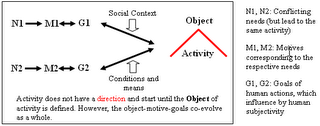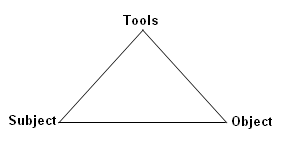The story of a crying farmer
Let's apply Activity Theory to analyze the "vegetable growing activity" by the old farmer.
The object of the activity could be the grown vegetable. We don't know the farmer's needs and motivation behind this object. It could be motivated by his need to feed himself, or to fulfil a promise to his dead wife, well, only he knows. In order to achieve his object, we can assume that he started a series of actions such as weed the grass, plant the seeds, water daily, etc, in different stages, under different situations and conditions, and mediated by different tools.
The story focuses at the growing stage. The goal was to raise the leaf up. To achieve this goal, he consciously carried out a series of actions, one after another despite the failure. He was determined to "raise the leaf up". He thought hard and experimented with different tools, e.g. He used the traditional pail and water; knife and stick; came up with innovative use of nails and magnet; string and balloon; and by coincidence, he found the most effective one being his tears! Once he found a good way (model) to achieve his goal of raising the leaf up, he immediately started another series of actions to improve the model. The goal now is to generate more tears. He achieved this goal by yet another series of actions, namely 1. Using a machine that used onion, hammer, and needle to generate pain (hence generate more tears); 2. Using his dead wife's skull to generate sadness; and 3. Reading sad story to generate tears. We can imagine that the crying farmer was so good at these actions that they became his daily routine operations. Occassionally, the hammer installed at the machine might break down and the farmer would need to do the hammering manually. Thus, the routine "hammering" operation returns to its conscious action.
We can reason that the sad ending (undersirable outcomes) was because the crying farmer had left out an important pest control stage. He wasn't aware of the presence of the snails, which were part of the community, and they too were motivated by the same object of the activity (the grown vegetables). We can also assume that this negligence (can't possibly happen to an experienced farmer) was due to the fact that he was totally exhausted after working on such a huge field and we all know that crying was a very tiring task. Despite being such a focused and effective worker in achieving his goals, because of a negligence - he forgot the existence of other members (the snails) in the same activtiy system (even if they are unwelcome), the activity that he had so deligently and whole heartedly crafted had cost his life and many other lives.
Even though the crying farmer is fictitious, we see too many crying farmers around us. We "cry" at the undesirable outcomes generated by a failed activity even if its object is a noble one. We "cry" at our carelessness (a wrong or inappropriate step), our negligence of the members in a community, or our ignorance to the changes in environmental conditions that jeopardise the whole activity. Worst of all, we sometimes are so focus at the tasks that we are not consciously aware of the activity we're participating and hence its object. It is not uncommon to hear urban workers crying, "Why are we doing all these (tasks)?", "I'm so busy everyday but I don't know what I'm busy at?"
I find Activity Theory useful in providing us with a vocabulary for talking about human activity in meaningful terms and giving us the necessary attention to what we bring to a situation.
We can never be certain of the consequences of our actions and be fully aware of a situation, which implies that we can't be sure we will achieve the object of the activity that leads to desirable outcomes. However, human beings are good learners. We can learn to become aware of some of our prejudices (or pre-understanding) and our actions, and in that way emancipate ourselves from some of the limits they place on our thinking.
In the next session, I'll discuss a useful tool developed by Engestrom. He extended Activity Theory by adding another main component "community" (those who share the same object of activity) to the subject-tool-object structure. The new structure enables explicit consideration of the systemic relations between an individual and his environment.
The object of the activity could be the grown vegetable. We don't know the farmer's needs and motivation behind this object. It could be motivated by his need to feed himself, or to fulfil a promise to his dead wife, well, only he knows. In order to achieve his object, we can assume that he started a series of actions such as weed the grass, plant the seeds, water daily, etc, in different stages, under different situations and conditions, and mediated by different tools.
The story focuses at the growing stage. The goal was to raise the leaf up. To achieve this goal, he consciously carried out a series of actions, one after another despite the failure. He was determined to "raise the leaf up". He thought hard and experimented with different tools, e.g. He used the traditional pail and water; knife and stick; came up with innovative use of nails and magnet; string and balloon; and by coincidence, he found the most effective one being his tears! Once he found a good way (model) to achieve his goal of raising the leaf up, he immediately started another series of actions to improve the model. The goal now is to generate more tears. He achieved this goal by yet another series of actions, namely 1. Using a machine that used onion, hammer, and needle to generate pain (hence generate more tears); 2. Using his dead wife's skull to generate sadness; and 3. Reading sad story to generate tears. We can imagine that the crying farmer was so good at these actions that they became his daily routine operations. Occassionally, the hammer installed at the machine might break down and the farmer would need to do the hammering manually. Thus, the routine "hammering" operation returns to its conscious action.
We can reason that the sad ending (undersirable outcomes) was because the crying farmer had left out an important pest control stage. He wasn't aware of the presence of the snails, which were part of the community, and they too were motivated by the same object of the activity (the grown vegetables). We can also assume that this negligence (can't possibly happen to an experienced farmer) was due to the fact that he was totally exhausted after working on such a huge field and we all know that crying was a very tiring task. Despite being such a focused and effective worker in achieving his goals, because of a negligence - he forgot the existence of other members (the snails) in the same activtiy system (even if they are unwelcome), the activity that he had so deligently and whole heartedly crafted had cost his life and many other lives.
Even though the crying farmer is fictitious, we see too many crying farmers around us. We "cry" at the undesirable outcomes generated by a failed activity even if its object is a noble one. We "cry" at our carelessness (a wrong or inappropriate step), our negligence of the members in a community, or our ignorance to the changes in environmental conditions that jeopardise the whole activity. Worst of all, we sometimes are so focus at the tasks that we are not consciously aware of the activity we're participating and hence its object. It is not uncommon to hear urban workers crying, "Why are we doing all these (tasks)?", "I'm so busy everyday but I don't know what I'm busy at?"
I find Activity Theory useful in providing us with a vocabulary for talking about human activity in meaningful terms and giving us the necessary attention to what we bring to a situation.
We can never be certain of the consequences of our actions and be fully aware of a situation, which implies that we can't be sure we will achieve the object of the activity that leads to desirable outcomes. However, human beings are good learners. We can learn to become aware of some of our prejudices (or pre-understanding) and our actions, and in that way emancipate ourselves from some of the limits they place on our thinking.
In the next session, I'll discuss a useful tool developed by Engestrom. He extended Activity Theory by adding another main component "community" (those who share the same object of activity) to the subject-tool-object structure. The new structure enables explicit consideration of the systemic relations between an individual and his environment.



